- Organic search traffic is one of the best ways to get a consistent revenue stream, it creates opportunity for any store owner; because even without a known brand, your audience can still discover you.
- There are many paid-for tools available for SEO, and although they do provide technical deep insights, the important core factors for SEO are often lost on novices and newcomers.
- Learn how to quickly assess your store’s traffic and SEO positioning using entirely Free tools available online in this quick guide!
What Keywords Are You Ranking For?
👉 Every minute, 2.4 million searches are performed, and there are an estimated 50 billion results indexed by Google now, so in this huge sea of data – there’s simply no point having first page results for keywords that are not being searched.The sky is the limit – You can optimize for any keyword you desire, it’s ensuring you are ranking for the right keywords that are crucial in obtaining an effective strategy.
Getting a ranking for your unique brand name, which may not have any competition – isn’t very difficult, and will come naturally as your brand ages and your presence develops over time.
The challenge that’s worth chasing here, is getting a ranking for a specific keyword that’s being searched for frequently.
Steps:
- Login to your Google Search Console to see how your SEO performance is doing,
- If you haven’t set up your account yet, you’ll need to wait for data to populate.
- Don’t wait to make a Search Console account – Start today because you’ll need to monitor these dashboards in order to know for sure what’s happening with your SEO.
- Click the Performance link on the left-hand side, and you can then scroll down to view your queries (keywords)
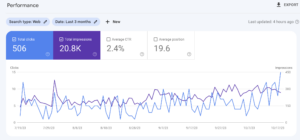
Scrolling down the performance page you can view the queries (keywords) on your pages and also device and country information.
For any SEO work you do, viewing this screen and ordering by Clicks or Impressions is the last true acid test to know if it’s really worked, besides running a search and seeing where you appear.
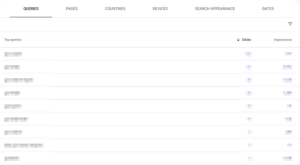
👉 Be aware that relying on the latter method of running a search to check for your position may not be 100% accurate – Because continually searching for your own company, combined with your browsing history/cookies, will mean your search results are tailored by Google, and not the same as what other new prospects may find, to make certain – always use a private incognito window to test a keyword for sure.
How Do I Find Good Keywords For Free?
To discover what keywords are searched every day and hold value without paying for access to a premium tool, you can use Google Keywords Planner to get a general idea of what keywords are in high demand and which ones are rarely (if ever) searched for.
Steps:
- Login to your Google account and go to the Google ad’s Keyword Planner to start finding viable keywords for Free: https://ads.google.com/aw/keywordplanner/
- Enter your keywords, or use your website URL (or a competitor / inspirational source)
- Order the results by Average monthly Searches.
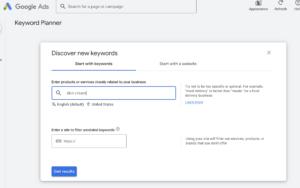
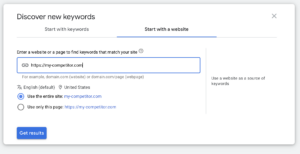
👉 You can enter keywords or a URL to a competitor, or page on your website to generate keywords from.
Once you have run your search, order the results table by Avg Monthly Searches, so you can see the number of searches being made.
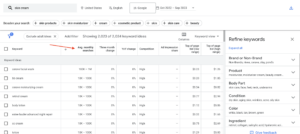
You can also view the competition and bid prices, which can shed some light on the efficacy of each keyword but shouldn’t be taken too closely for every business because bidding can occur due to saturation and skew pricing just because of overcrowding around a keyword trend that’s existed for many years and become a core part of a leaders strategy.
💡 Be creative! Looking for alternatives and long tail phrases that still get traffic but are not overly being bid on is a highly beneficial and effective strategy to find good keywords.
Putting It All Together
👉 Now you have both a monitoring and a planning tool; it’s time to get a plan of action together and try optimizing for some keywords!
The last free tool you’ll want to use is Google Sheets, which is integrated into the Ads planner, meaning you can easily create a spreadsheet and track everything in an organized way.
Steps:
- Export out your keywords from the planner, and start compiling a list in your Google Sheets.
- Add a column for ‘Raw Competition’ and ‘Direct Competition.’
- Search each keyword in Google, and copy and paste the number of results into the Raw Competition column
- Use the allinanchor: operator to search for the keyword’s direct competition and collect the results in your spreadsheet under a
- With columns as Keyword, Avg Monthly Searches, Raw Competition, Directly Competing – Now Add the formula =
(B2^2)/C2to calculate the efficacy of the keyword; order by the column to see how your list shapes up!

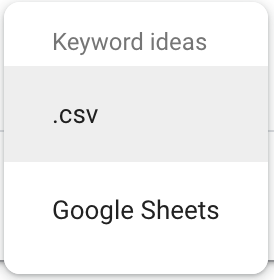
In the top right corner of your keyword planner is a export option

Copy paste the number of results for your Raw Competition, in this case it’s 1,520,000,000
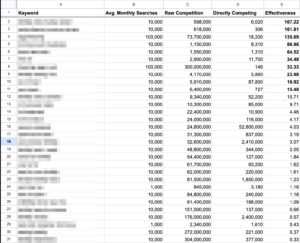
Once your spreadsheet is filled out, you can order. by the effectiveness, you are calculating and begin to really see what keywords are worth going after!
And there you have it – none of these tools cost any money; it’s just time to crunch the numbers, and as time is money, it’s never truly free. What’s worth knowing, though is even with paid-for tools, although you get many detailed stats and keyword analytics, you do not necessarily get the insights you can obtain from doing this research yourself.
👉 For business success, and especially e-commerce, I believe it is crucial to embrace the chore of keyword research and routinely check keywords, even keep a ongoing mental note throughout the years of keywords you see, and keywords you use that hold relevance to your businesses.
Onwards From Here, Optimizing The Long-Tail
Now that you can identify a keyword shortlist and find the effectiveness of big hitters, it’s time to put your attention on more specific, longer multiple-phrase keywords that are not optimized for, and therefore have a limited supply.
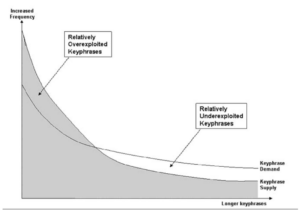 © David Viney
© David Viney
💡 Get back to basics – Using the methods and free tooling outlined above, you can now identify a keyword that has high demand and low supply – with this most fundamental economic law of supply and demand, you will find a golden opportunity.
